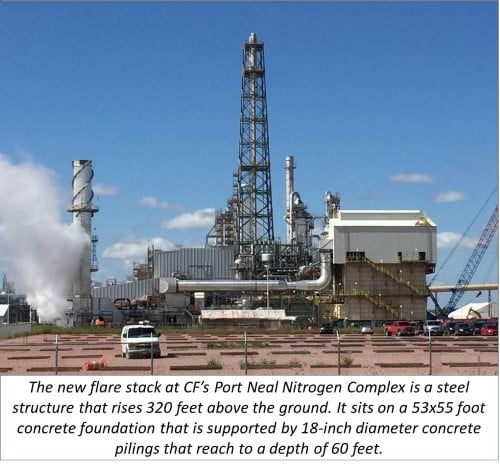Port Neal Flare Stack Overview
By: Corporate Communications
October 12, 2016
Company, Safety
Share
As CF continues the commissioning of the new ammonia plant at its Port Neal Nitrogen Complex in Sergeant Bluff, Iowa, parts of the Siouxland area will see a significant flame rise from the plant’s 320-foot-tall flare stack.
If you are unfamiliar with this standard safety feature at chemical plants similar to Port Neal, please take a moment to review the information below. If your questions are not addressed here, please contact the plant at 712-823-1243.
What does it mean that there is a flame coming from the flare stack?
The ignition of the flare stack means that the plant is operating as designed. It is not a cause for alarm or concern.
What is a flare stack?
A flare stack is a gas combustion device used in industrial plants such as petroleum refineries, chemical plants and natural gas processing plants. During plant or partial plant startups and shutdowns, flare stacks are often used for the planned combustion of gases over relatively short periods so that they are not released directly to the environment. In industrial plants, flare stacks are also used for burning off flammable gas released by pressure relief valves during unplanned over-pressuring of plant equipment.

How high will the flame rise?
The flame from the Port Neal flare stack will rise up to 200 feet from the top of the flare stack. Since the stack itself is more than 300 feet tall, the top of the flame could reach as high as 500 feet above the ground.
How far away will you be able to see the flame?
You will be able to see the flame from a significant distance – likely several miles – though it will be visible from a greater distance at night than during the day. We expect residents of several surrounding communities, as well as travelers on Interstate 29, approximately two miles east of the Port Neal plant, to be able to see the flame.
Will there always be a flame coming from the flare stack?
No. The flare stack is used at specific times – such as starting-up or shutting down the ammonia plant.
Will neighboring communities be alerted when the flare stack is ignited?
Prior to the start-up of the new ammonia plant, the Port Neal team is taking a number of steps to educate our neighbors about the flare stack and what it means because it is unique to our area. After the plant is started up, our focus will be on informing emergency responders and the Sioux Gateway Airport should the flare stack be ignited for either planned procedures or other circumstances.
Will the flare stack affect operations at Sioux Gateway Airport?
CF has worked closely with the Federal Aviation Administration and Sioux Gateway Airport to ensure safety for planes departing from and arriving at the airport. In addition to communicating use of the flare stack, we will also illuminate it nightly so that it is visible to pilots.
Who reviewed and approved the plans for using the flare stack?
Flare design and operation was approved by the Iowa Department of Natural Resources (DNR) and the U.S. Environmental Protection Agency (EPA). It is subject to Best Available Control Technology requirements under the EPA’s federal air permitting program. The air permit contains emission limits, operating limits, and monitoring requirements for the flare. The air permit also required CF to develop and implement a Flare Minimization Plan, which must be approved by Iowa DNR before operation of the flare.
